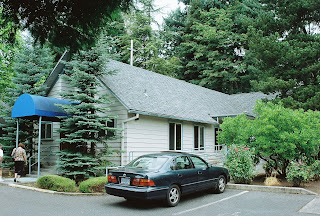St. Andrew, 806 NE Alberta Street
St. Andrew (which everyone calls St. Andrew's) is located in NE Portland. The first thing one notices is the beautiful old church building. It was built in the Gothic style, with light brown bricks and concrete adornments. Additionally, there is an attractive modern building that appears to serve as a community outreach center next to the church and what appears to be the rectory.
The interior of the church is cavernous, devoid of columns one might expect in a Gothic style church. The interior gives a visitor the first clue of the the parish's outlook. The pews, rather than all facing the altar, circle around an oval area which has an altar at one end and a reading podium at the other. Many of the pews lack kneelers. And , during the portion of the Mass where one typically kneels, only a small portion of the congregation did so.
Although the church has many large traditional stained-glass windows depicting Saints, the view of these windows is partially obscured by long green banners hanging from the ceiling and many small speakers, also hung by wire from the ceiling. On this cloudy day, the church also lacked sufficient interior lighting to show off the charms of its interior. Lastly, the light pink and light green paint scheme looked ready for a change.
Normally, there is a 9:30 English Mass and a 12 noon Spanish Mass. However, because of a church picnic this afternoon, Mass today was at 10:30. The Mass was 60% in Spanish and 40% in English. Fr. Chuck (Monsignor Charles Lienert) gave two homilies, one in Spanish followed by one in English. Fr. Lienert did a good job making an effort to pronounce the Spanish words properly.
This parish strongly emphasizes social justice. My experience with social justice churches -- and people in general who care deeply about social justice -- is they are far more concerned about systemic problems or systemic evil than they are about the evil in an individual. Fr. Lienert's sermon today makes my point. The Gospel reading was the parable of the wedding banquet where Jesus admonishes his listeners not to choose the best seat at a wedding lest the host ask the guest to give up his/her seat for a more important person. It seems to be a lesson on humility; in fact the host in the parable says,
"For every one who exalts himself will be humbled,
but the one who humbles himself will be exalted.” (
Luke 14:1, 7-14 was today's reading.)
However, Fr. Lienert said that the parable is
not principally about humility, but is instead about how
systems should treat people. He said that Jesus' admonition in the Gospel reading to, "invite the poor, the crippled, the lame, the blind" when you hold a banquet, was directed toward what "systems" should do. While I cannot say with any authority who the passage is primarily directed to (the individual or the system/government), I do think it is quite telling that Fr. Lienert downplayed the most obvious interpretation and said that the passage was primarily directed to "the system."

Fr. Lienert next told a story about a priest on a committee at the Second Vatican Council who proposed abolishing all titles in the Church. In fact, under this priest's proposal people would be forbidden from referring to the Pope as "your holiness" or "your eminence." Fr. Lienert said that that priest was now 80 and it was his wish that there be a Pope John 24 who would establish just such a rule. Fr. Lienart, apparently a fan of the proposal, said it would, among other things, promote equality for women in the Church. At this, half the congregation erupted in applause. When the homily finished there was more applause.
It struck me as odd that in a time when many in the Church are saying that Vatican II went too far, here was a group that thought that Vatican II did not go far enough. I wondered if St. John Vianney, St. Francis, St. Bernadette and the other Saints on the stained-glass windows would think that abolishing titles would be a good idea. I also thought of the parallels of this idea with the ideas of Communism: how a hierarchy formed in Communism despite the purported aim of equality of men--with party apparatchiks at the top.

While perhaps commendably idealistic, the "no titles" idea seemed naive to me. It, and everything about St. Andrew seemed to me to be informed by the 1960s. Women's Liberation, stopping the oppression of minorities by white men, "black power," "viva la raza," etc. Long hair for men has been replaced by facial hair. If any of these things resonate with you, you will love this church. On the conservative-liberal scale it is on the far end of the liberal side. Compare it to Holy Rosary, which is old-fashioned to the point of not having a "handshake of peace" during the Mass. At St. Andrew, the handshake of peace lasted five minutes! (The highlight of which for me was shaking hands with
Sally Cohen, who recently made it to the finals of American's Got Talent as a "hand-whistler.")
A final example of the left-leaning political bent of St. Andrew is that during the prayers, the woman leading the prayers prayed for "the people of Iran and Iraq." Not a word about American soldiers in harm's way.
To be fair, I think this church meets the needs of many. Furthermore, my guess is that the church "walks the talk" when it comes to social justice. The
parish website mentions several such ministries.



 €
€


































